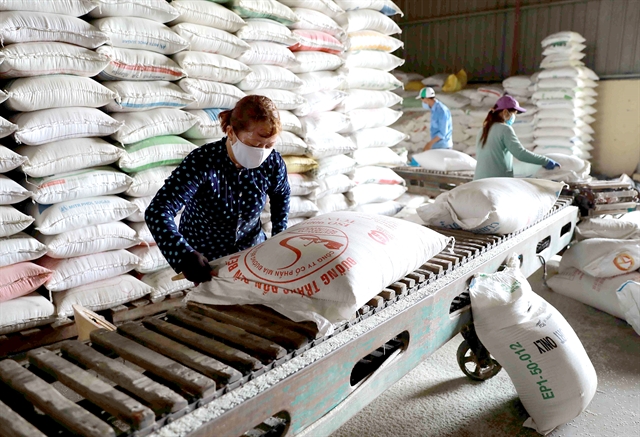 Economy
Economy

 |
| A rice packaging production line. — VNA/VNS Photo Vũ Sinh |
HÀ NỘI — The Việt Nam Chamber of Commerce and Industry (VCCI ) has raised concerns over the Ministry of Industry and Trade's proposal to limit imports of low-quality rice.
In the draft amendment to Decree No 107 on rice trade which is currently in the consultation process, the MoIT proposed management regulations of rice imports, especially imports of low-quality rice from overseas markets.
Without adequate and timely management and statistics, sharp increases in rice import volumes would potentially influence domestic production and indirectly affect food security, the MoIT explained.
The MoIT stressed the importance of issuing management policies on rice imports according to the criteria of volume, value, type, markets, importers; import border gates. That would help State management agencies proactively and promptly regulate and manage rice import activities in each period.
In the draft amendment, the ministry also suggested stiffer penalties for rice traders who failed to make quarterly and annual reports on exports and inventories as required as in the past three years, many rice exporters had failed to report or reported incompletely their export contracts, the implementation of their contracts, and their quarterly and annual inventories. This caused many difficulties for the State rice export management.
But according to VCCI, the draft did not provide clear criteria for assessing any increase in imports that could affect domestic production, and did not specify what measures were to be taken.
The application of import restrictions might affect other domestic manufacturers, increasing production costs, leading to input shortages and reducing competitiveness of Vietnamese goods, VCCI said.
It added that import management measures, if applied, should consider the needs of businesses that used raw materials for their production.
Last year Việt Nam imported nearly one million tonnes of rice from various countries. Of the total, 72 per cent came from India and was mainly used to make noodles, cakes, animal feed, beer, and liquor.
Amid the controversy on low-quality rice import, Vietnamese rice exports continued to increase over the past 11 months.
Statistics from the Ministry of Agriculture and Rural Development (MARD) showed that 600,000 tonnes of rice were shipped abroad in November, earning the country US$296 million.
The latest addition brought volume of rice exported to overseas markets in the 11 month-period total up to 6.69 million tonnes valued at $3.24 billion, up 16.3 per cent and 7 per cent year-on-year.
According to the MARD's agricultural product market bulletin in November 2022, the exported price of Vietnamese 5 per cent broken rice was $438 per tonne, $13-$28 higher than that of Thailand and $60-$65 higher than that of Indian.
The ministry attributed these increases to a decrease in supply amid increasing demand especially for hi-quality rice products from the European markets and rising demand for fragrant rice in other major markets such as the Philippines and China.
It added that Việt Nam's rice exports have many advantages so far this year when the traditional rice buyer - the Philippines, increased imports from 2.9 million tonnes to 3.4 million tonnes.
The Chinese market also shifted from importing a small volume of rice from Việt Nam at the beginning of the year to a large volume at the end of the year. Meanwhile, some European countries tended to import more rice to replace the reduced supply of wheat due to the Russia-Ukraine conflict.
Trade experts said that prices of Vietnamese rice would continue to stay high as economic and political uncertainties would push up food demand. They suggested exporters utilise opportunities in market access and expansion.
If the export volume was maintained at over 400,000 tonnes in the remaining month, the whole year’s export volume of the staple would reach from 6.8-7 million tonnes, they said.
Export businesses were urged to pay due attention to China, a big and promising market of Vietnamese farm produce. Recently, China has made changes in import requirements, from plant quarantine to packaging, tracking of origin and growing area codes.
A total of 22 Vietnamese firms have been licensed to ship rice to China, and Việt Nam has proposed China expand the list.
Apart from China, the EU and the UK have also remained Việt Nam’s important markets, experts said, suggesting exporters tighten their connectivity with purchasing and processing units to satisfy technical requirements of importers, thus better utilising free trade agreements (FTAs) and export quotas. — VNS




